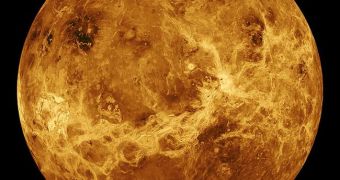According to officials at the Japanese Aerospace Exploration Agency (JAXA), the Venus-bound orbiter the organization launched earlier this year swung past the planet on Monday, but failed to achieve orbital insertion.
As such, the probe is now traveling through space without a clear target. Experts calculate that it will be in the correct position to attempt a new insertion maneuver in about seven years.
If that is deemed impossible, then the mission will be considered a complete failure. The spacecraft had traveled for more than six months before arriving at Venus this Monday.
At 6:49 pm EST (2349 GMT) on December 6, the Akatsuki probe began firing its thrusters for the orbital insertion maneuver, and entered a communications blackout that was supposed to last precisely 22 minutes.
But the blackout extended for about 90 minutes, which gave JAXA mission controllers the first indication that something was wrong with the spacecraft. Once contact was resumed, it was determined that the probe had sped past Venus.
JAXA officials made the announcement in a press conference held yesterday, December 7, according to reports in the newspaper Japan Today, quoted by Space.
“I'm sorry that we failed to meet the expectations of the public,” said at the conference the Akatsuki project manager, Masato Nakamura.
The news service Agence-France Presse (AFP) reports that JAXA mission planners are currently assessing the feasibility of a plan that calls for Akatsuki to be inserted in Venusian orbit in seven years.
It's only then that the spacecraft will pass close enough to the planet so that it can attempt this maneuver. At this point, Akatsuki has insufficient fuel to stop its course, and return to Venus.
The spacecraft launched on May 20 aboard a H-2A delivery system, together with the IKAROS solar sail demonstrator. The latter was successful in showing that the power of sunlight can be harnessed for space travel.
Among the mission's primary objectives, experts included the discovery and analysis of lightnings and active volcanoes, as well as studies of the planet's clouds. Recently, it was determined that the Venusian sulfur cycle is not as well understood as experts liked to think.
Another one of the greatest mysteries related to the Venusian atmosphere is the presence of lightning in its clouds, given that most of the “air” there is made up of sulfuric acid and other similar compounds.
Understanding the Venusian “super-rotation,” the phenomenon that causes the formation of powerful winds in the atmosphere, was also one of the main topic of study.
This process drives around clouds at speeds of over 360 kilometers per hour, or 220 miles per hour. This means that the atmosphere spins about 60 times faster than Venus itself does.

 14 DAY TRIAL //
14 DAY TRIAL //